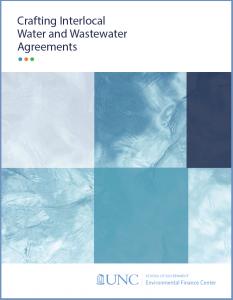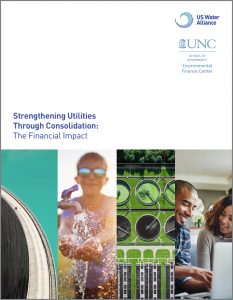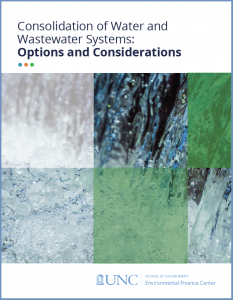In the past few years, the EFC has been asked to evaluate the different financial impacts of regionalization, from simple shared services agreements to full-on consolidation. Additionally, we have been evaluating barriers to and opportunities for the creation of new and different governance models. We have identified some key takeaways and, in the process, developed quite a few useful resources that might be of interest to communities or state and local leaders interested in moving the needle toward more regionalization in the water sector.
1. There are many reasons why systems and decision makers should consider regionalizing.
In our work with water and wastewater systems across the country, we have uncovered many reasons that warrant investigating a regional solution.
- Efficiencies of Scale – This is one that probably comes to most people’s minds and is also the outcome that everyone is hoping for. In general, a well-crafted regional partnership should offer some efficiencies of scale because it allows for shared services, personnel, and infrastructure.
- Failing or Aging Infrastructure – Infrastructure-related challenges have driven much of the legislative drive for regionalization. The hope is that by regionalizing, systems can spread out exorbitant capital needs that can’t be covered by a system on its own.
- Unaffordable rates – Whatever the cause may be, whether it is a dwindling customer base, a new investment in capital projects, or external rate increases outside of the control of the utility, when utilities are looking toward an increase in rates that will make the service unaffordable for much of the customer base, regionalization might be a way to help reduce that impact.
- Water Supply Needs – Many systems are facing increased periods of drought, while others are being impacted by contaminated source water due to flooding. Additionally, some systems are in areas where growth is increasing their water supply needs, and some systems have shrinking demand. Regional partnerships can offer some solutions to address water supply needs and variations.
- Population Changes – Some of the EFC’s work involves working with systems where even within one county, there is an enormous disparity between population growth and decline. This natural shifting of growth in the country provides some potential for regional partnering.
- Regulatory Compliance – For some systems, the best path toward complying with state and federal regulations will be a regional partnership to get them back on track.
Whatever the reason for partnering, the EFC has created some recent resources that can be of assistance as state and local communities move forward.
2. Good contracting makes for better partnerships.
In assisting local governments across North Carolina and the country, the EFC consistently stumbles upon contracts that are lacking in depth and detail. One of the tools that local governments in North Carolina utilize to partner is interlocal agreements. While such agreements are not limited to the water sector, there are hundreds across North Carolina that involve water or wastewater services. There is no single template to use for all such contracts, but there are many topics that parties to a contract may want to address in their written agreements to make more robust and lasting contracts. Examples of such topics include:
- Ambiguities related to current and future service areas

- Precisely defined key usage thresholds and limits
- Meter maintenance and ownership responsibilities
- Non-revenue water
- Excessive inflow and infiltration
- Many More!
As part of the EFC’s contract with the NC Division of Water Infrastructure, we put together a guide on interlocal agreements. The guide provides a good starting point for discussions with potential or existing partners about creating new agreements or modifying existing ones.
3. Effective communication about regionalization is critical.
For some, terms like “regionalization” and particularly “consolidation,” carry with them negative connotations. Some local government representatives, board members, elected officials, or even rate payers, may feel threatened by working with other systems in some regionalized capacity. Thus, it is important to use simplified resources, and effective tools to communicate your messages, ranging from explaining the need for partnering, the impact on rates, and the complexities of any actual partnership agreement.
At the EFC, we use a lot of one-page documents to capture the key discussion points about issues such as regionalization or consolidation. We also use excel based tools to evaluate system health or to gauge the affordability of certain rate structures. Further, we are always generating new infographics to simplify some of the more technical concepts and make them easily digestible by a broader audience. These tools provide visualizations or simplified text that allows for better communication to the important decision makers involved in water sector decision making.
Recently, we had the opportunity through one of our projects funded by EPA, to create a simplified video to discuss some of the topics covered in the interlocal agreement guide mentioned above. It boils down to the need for good contracting to a five-minute video. As you consider your own regional partnership opportunities or existing relationships, consider the most effective ways to communicate so that your messages come through.
4. There is a broad range of financial impacts involved in consolidation.
In 2018, the EFC conducted eight consolidation case studies across the US, as part of a project funded by the US Water Alliance. The report, Strengthening Utilities Through Consolidation: The Financial Impact, focuses on the financial outcomes and impacts of the consolidations.
Rather than approaching the case studies with a narrow lens focused only on the rate impacts, the EFC delved into all the financial implications it could identify as associated with the consolidations.  While there are of course costs and considerations related to consolidation, for the most part, the economic or financial benefits observed in the case studies were abundant, ranging from economies of scale, to lower or equalized customer rates, to increased opportunities for economic development.
While there are of course costs and considerations related to consolidation, for the most part, the economic or financial benefits observed in the case studies were abundant, ranging from economies of scale, to lower or equalized customer rates, to increased opportunities for economic development.
For systems considering consolidation, the report provides a great summary of some on the ground consolidations and how the different financial benefits played out for the different systems. Sometimes identifying and highlighting the different potential financial benefits, beyond impacts on customer rates, is necessary to garner support from key decision makers in communities considering consolidation.
5. There is no single road map to consolidation of water or wastewater systems.
In providing environmental finance-related guidance to systems and communities, we often emphasize the need to “customize your solutions.” A rate structure that works for my community might not work two counties away. Likewise, there is a multitude of unique characteristics that should be a part of a community’s considerations of whether consolidation is a possibility, such as vulnerability to flooding or drought, affordability of rates, diversity of revenue sources, population changes, current conditions of infrastructure, political climate – the list goes on. Each of these characteristics and others also factor into whether consolidation is feasible for a community or group of communities, and if so, what that consolidation might look like.
The EFC has been working with state and local leaders in North Carolina for the past several years on providing input and assistance to communities trying to figure out what a path forward might look like if consolidation were to be pursued.  As part of its work for the Division of Water Infrastructure, the EFC has put together a resource guide that helps utilities, community leaders, or other decision makers walk through the different considerations for potential consolidation options.
As part of its work for the Division of Water Infrastructure, the EFC has put together a resource guide that helps utilities, community leaders, or other decision makers walk through the different considerations for potential consolidation options.
The guide starts with a breakdown of different forms of consolidation and the models that exist currently in North Carolina, many of which also exist in other states. The guide then provides a step-by-step checklist to be used when navigating discussions related to consolidation. Like the Interlocal Agreement guide referenced above, this guide is intended to be a living document, influenced by real-world examples, and focused on the considerations, but not necessarily the outcomes.
What sort of resources have you come across to help communities work toward regionalization in the water sector?

